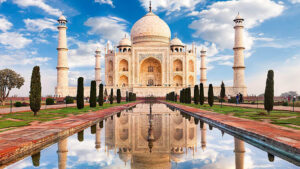Mughal Architecture
(Relevant for Historical Section of General Studies Paper Prelims/Mains)

Mughal Architecture
This architectural style thrived in the northern and central regions of India during the rule of the Mughal emperors from the mid-16th century to the late 17th century. The Mughal era brought about a notable resurgence of Islamic architecture in northern India. With the support of Mughal emperors, a fusion of Persian, Indian, and regional styles gave rise to exceptional and refined creations. This architectural trend became so pervasive, particularly in northern India, that its influences extended even into the colonial architecture of the Indo-Saracenic style.
Features
- Eclectic Architecture: This style emerged as a fusion of Indian, Persian, and Turkish architectural elements.
- Variety: A diverse range of structures including grand entrances, forts, tombs, palaces, mosques, and rest houses.
- Construction Materials: The predominant use of red sandstone and white marble.
- Distinctive Features: Notable characteristics encompassed the Charbagh layout for tombs, prominent bulbous domes, slim corner turrets, expansive gateways, intricate calligraphy, and arabesque motifs, geometric designs on pillars and walls, and palace chambers supported by columns. Archways, chhatris (domed pavilions), and assorted dome styles gained immense popularity in Indo-Islamic architecture and underwent further advancements during the Mughal era.
Examples
Taj Mahal: Commissioned by Shah Jahan between 1632 and 1653 as a tribute to his beloved wife Mumtaz Mahal. Acknowledged by UNESCO as a World Heritage Site in 1983, the Taj Mahal is situated in Agra.
Red Fort: Constructed by Shah Jahan in 1618 as part of his decision to relocate the capital from Agra to Delhi. It functioned as the residence for Mughal rulers. Designated as a UNESCO World Heritage Site in 2007.
Jama Masjid: Erected by Shah Jahan in Delhi, with completion achieved in 1656.
Badshahi Mosque: Raised during Aurangzeb’s reign, the Badshahi Mosque held the record as the world’s largest mosque upon its completion in 1673. It is situated in Lahore, the capital of the Pakistani province of Punjab.
Agra Fort
- It is a fortification in Agra.
- It was one of the earliest structures to be built during Akbar’s rule.
- The majority of the constructions inside the fort, however, were built during Shah Jahan’s reign. The following are some of the notable structures in the area:
- Moti Masjid by Shah Jahan.
- Diwan-i-aam (Hall of Public Audience) and Diwan-i-khas (Hall of Private Audience) by Shah Jahan.
- The Jahangiri Mahal.
- Sheesh Mahal (Turkish Bath).
Humayun’s Tomb
- This mausoleum, constructed in 1570, holds particular cultural significance due to being the inaugural garden-tomb on the Indian subcontinent.
- It served as an inspiration for several significant architectural advancements, ultimately culminating in the creation of the Taj Mahal.
- Its construction was sponsored by Humayun’s son, the renowned Emperor Akbar. Referred to as the ‘dormitory of the Mughals,’ it contains the remains of more than 150 members of the Mughal family.
- Exemplifying the charbagh style (featuring a four-part garden symbolizing the rivers of the Quranic paradise), it incorporates pools interconnected by water channels. The United Nations Educational, Scientific and Cultural Organization (UNESCO) bestowed World Heritage Site status upon it in 1993.
To master these intricacies and fare well in the Sociology Optional Syllabus, aspiring sociologists might benefit from guidance by the Best Sociology Optional Teacher and participation in the Best Sociology Optional Coaching. These avenues provide comprehensive assistance, ensuring a solid understanding of sociology’s diverse methodologies and techniques.
Mughal Architecture, Islamic Architecture, Persian Influence, Taj Mahal, Red Fort, Jama Masjid, Badshahi Mosque, Agra Fort, Humayun’s Tomb, Charbagh Layout, UNESCO World Heritage Sites, Indian History, Architectural Styles, Shah Jahan, Akbar, Aurangzeb, Best Sociology Optional Coaching, Sociology Optional Syllabus.

Choose The Best Sociology Optional Teacher for IAS Preparation?
At the beginning of the journey for Civil Services Examination preparation, many students face a pivotal decision – selecting their optional subject. Questions such as “which optional subject is the best?” and “which optional subject is the most scoring?” frequently come to mind. Choosing the right optional subject, like choosing the best sociology optional teacher, is a subjective yet vital step that requires a thoughtful decision based on facts. A misstep in this crucial decision can indeed prove disastrous.
Ever since the exam pattern was revamped in 2013, the UPSC has eliminated the need for a second optional subject. Now, candidates have to choose only one optional subject for the UPSC Mains, which has two papers of 250 marks each. One of the compelling choices for many has been the sociology optional. However, it’s strongly advised to decide on your optional subject for mains well ahead of time to get sufficient time to complete the syllabus. After all, most students score similarly in General Studies Papers; it’s the score in the optional subject & essay that contributes significantly to the final selection.
“A sound strategy does not rely solely on the popular
Opinion of toppers or famous YouTubers cum teachers.”
It requires understanding one’s ability, interest, and the relevance of the subject, not just for the exam but also for life in general. Hence, when selecting the best sociology teacher, one must consider the usefulness of sociology optional coaching in General Studies, Essay, and Personality Test.
The choice of the optional subject should be based on objective criteria, such as the nature, scope, and size of the syllabus, uniformity and stability in the question pattern, relevance of the syllabic content in daily life in society, and the availability of study material and guidance. For example, choosing the best sociology optional coaching can ensure access to top-quality study materials and experienced teachers. Always remember, the approach of the UPSC optional subject differs from your academic studies of subjects. Therefore, before settling for sociology optional, you need to analyze the syllabus, previous years’ pattern, subject requirements (be it ideal, visionary, numerical, conceptual theoretical), and your comfort level with the subject.
This decision marks a critical point in your UPSC – CSE journey, potentially determining your success in a career in IAS/Civil Services. Therefore, it’s crucial to choose wisely, whether it’s the optional subject or the best sociology optional teacher. Always base your decision on accurate facts, and never let your emotional biases guide your choices. After all, the search for the best sociology optional coaching is about finding the perfect fit for your unique academic needs and aspirations.
To master these intricacies and fare well in the Sociology Optional Syllabus, aspiring sociologists might benefit from guidance by the Best Sociology Optional Teacher and participation in the Best Sociology Optional Coaching. These avenues provide comprehensive assistance, ensuring a solid understanding of sociology’s diverse methodologies and techniques. Sociology, Social theory, Best Sociology Optional Teacher, Best Sociology Optional Coaching, Sociology Optional Syllabus.
Best Sociology Optional Teacher, Sociology Syllabus, Sociology Optional, Sociology Optional Coaching, Best Sociology Optional Coaching, Best Sociology Teacher, Sociology Course, Sociology Teacher, Sociology Foundation, Sociology Foundation Course, Sociology Optional UPSC, Sociology for IAS,
Follow us :


https://t.me/VikashRanjanSociology
Find More Blogs
|
Scope of the subject and comparison with other social sciences |
|||
|
|
|
|
Modernity and social changes in Europe |

